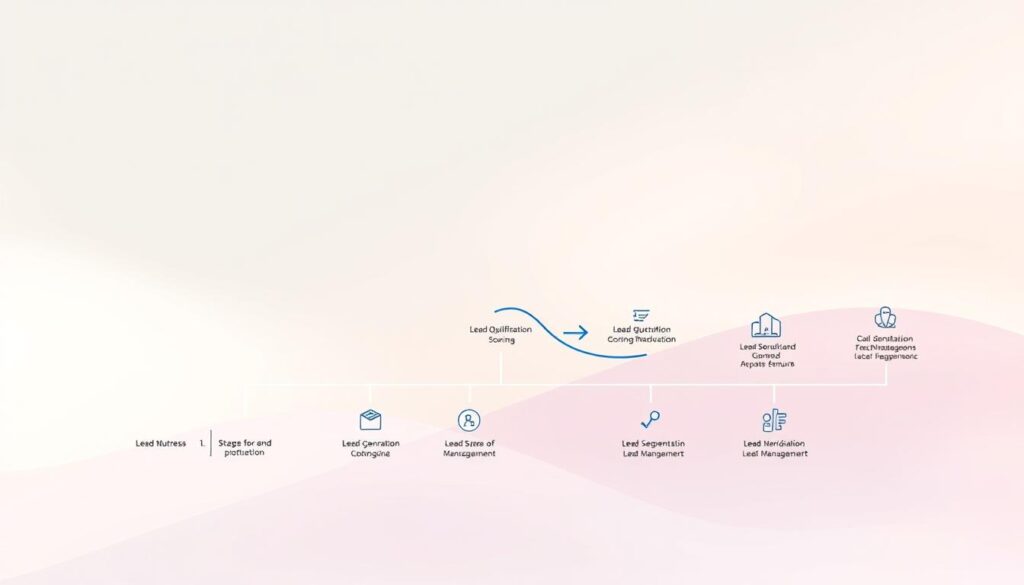Nowadays, businesses are increasingly adopting automated lead nurturing to boost their sales. It involves using strategies to keep in touch with potential customers. This method helps turn leads into dedicated customers, enhancing the sales funnel. With tools like advanced CRM and marketing automation platforms, no lead is overlooked. Sales teams can then focus more on making sales. Companies such as Convin are leaders in using AI for this purpose. It leads to better lead management and tracking all through the buyer’s journey.
Key Takeaways
- Automated lead nurturing enhances sales efficacy by engaging potential customers.
- It transforms leads into loyal customers through systematic communication.
- Effective use of CRM and marketing automation tools is essential.
- AI technologies streamline lead management processes.
- Strategically optimizing the sales funnel boosts lead conversion rates.
Understanding Automated Lead Nurturing
Automated lead nurturing is key for building strong customer relationships and boosting sales. It uses technology to keep in touch with potential customers during their shopping journey. This method makes sure each message fits what the lead has done, making interactions timely and relevant.
What is Automated Lead Nurturing?
It’s a way to handle leads by sending them custom messages and updates automatically. This uses tools that track how leads react to emails and what they do on websites. Using this information, companies can make experiences that really speak to potential customers, increasing the chances they’ll buy.
The Benefits of Automation in Lead Management
Bringing automation into lead management brings many benefits that make things more efficient and effective:
- Time Savings: Automation cuts down on manual work, letting sales teams focus more on sealing deals.
- Consistent Communication: With automated systems, leads always get follow-ups on time, which helps keep the relationship warm.
- Improved Lead Scoring: Sales technology helps figure out which leads are most likely to buy, based on their actions. This means teams can focus their energy better.
- Increased Conversion Rates: Sending personalized content when it’s most effective helps turn more leads into customers.
These benefits show that using automation can make lead management much smoother and more effective. Companies that adopt these methods are likely to see big improvements in their sales results.
The Lead Nurturing Process Explained
Understanding how to nurture leads is key to building lasting ties with potential clients. This journey involves vital steps that bring leads from discovering your brand to becoming faithful customers. By developing specific strategies for each step, you make sure leads get the right info at the right time.
Stages of Lead Nurturing
Lead nurturing has phases like awareness, engagement, evaluation, and conversion. In the awareness phase, companies introduce themselves through interesting and helpful content. Then, in the engagement stage, they keep leads interested with educational resources and quick responses.
Next, in the evaluation stage, leads think over their choices before deciding. This leads to the conversion stage, where they become customers.
Key Components of an Effective Nurturing Strategy
An effective lead nurturing strategy is built on several important parts. Knowing your audience is the base. It helps you make content that really speaks to potential clients. Adding tools like CRM software helps manage the process better by sorting leads and making things automatic. When all parts work together, you create a smooth journey that builds trust and loyalty.

For more tips on nurturing leads, take a look at effective nurturing strategies to better your marketing plan.
| Stage | Description | Goals |
|---|---|---|
| Awareness | Introducing the brand through targeted content. | Generate interest and educate leads. |
| Engagement | Providing educational materials and timely follow-ups. | Encourage interaction and gather insights. |
| Evaluation | Leads weigh options and assess value. | Facilitate informed decision-making. |
| Conversion | Leads become customers. | Achieve sales and establish relationships. |
Technologies Behind Automated Lead Nurturing
Automated lead nurturing uses different technologies to make the process better and more efficient. Tools like CRM and marketing automation platforms are key. They help manage leads and build relationships. With these technologies, companies can improve how they reach out and increase their sales.
CRM Tools for Lead Management
CRM tools like Salesforce, HubSpot, and Zoho are vital for handling leads. They help businesses keep track of interactions and understand lead behavior. These tools also score leads based on how they engage. This lets companies focus on the most promising leads and keeps their potential customer pool strong. This way, the buying experience feels more personal for each customer.
Marketing Automation Platforms
Marketing automation platforms automate many marketing tasks. This lets companies save time for bigger strategy planning. These tools help create targeted campaigns, segment audiences, and send personalized content easily. With these platforms, nurturing leads and maintaining tailored communication become much simpler. Follow-ups are timely, which helps turn more leads into customers. For more details, here’s a full guide.
AI and Machine Learning in Lead Nurturing
AI changes how businesses analyze data and connect with possible customers in lead nurturing. Machine learning predicts what customers might do next. This helps fine-tune targeting and make messages more personal. Using AI, companies can better their strategies, ensuring the right message reaches the right people at the right time. This approach improves how leads are handled and boosts marketing success overall.
Crafting Your Lead Nurturing Strategy
Creating a strong lead nurturing strategy helps build connections with future customers. It starts with knowing who your audience is. Understanding their background, likes, and problems lets you reach out effectively. With information from past interactions, companies can shape personalized content.
Defining Your Target Audience
Knowing your audience helps shape your marketing. Consider their:
- Demographics such as age, gender, and location
- Behavioral patterns and interests
- Challenges and pain points faced by potential customers
Creating Personalized Content
Personalized content is key to engaging leads. Insights about your audience help make messages that strike a chord. You can:
- Dynamic content that adapts based on user interactions
- Targeted email campaigns offering solutions to specific problems
- Customized landing pages that reflect individual preferences
Setting Goals and KPIs
It’s crucial to set clear goals and KPIs to track your strategy’s success. This involves determining:
| Goal | Key Performance Indicator (KPI) |
|---|---|
| Increase lead engagement | Open and click-through rates |
| Boost conversion rates | Number of leads converted to customers |
| Enhance customer retention | Customer lifetime value (CLV) |
By following these methods, companies can make a lead nurturing process that matches their goals. This process will help meet the needs of the audience.
Best Practices for Automated Lead Nurturing
Implementing top methods for automated lead nurturing boosts engagement and increases conversion rates. Good lead segmentation is key to any winning strategy, making sure messages talk right to specific groups. Leads are sorted by things like their industry, interests, and how much they interact, allowing for messages that truly speak to them.
Segmentation and Targeting
Correct lead segmentation lets businesses craft content that meets the special needs of each group. By dividing into specific segments, companies are more likely to have meaningful interactions. Targeting right ensures potential customers get info that matches their interests, building stronger bonds.
Timing and Frequency of Contacts
Choosing when and how often to contact is vital for lead nurturing. It’s important to pick the best times to reach out and figure out the right contact frequency. This balance keeps interest alive without overloading potential customers. Regular contacts improve brand presence and keep leads interested without spamming them.
Testing and Optimization
To perfect lead nurturing, testing and fine-tuning is a must. Marketers need to regularly check how their campaigns are doing to see what clicks with their audience. Tweaking strategies with what they learn from tests boosts results. This aligns with automated lead nurturing best practices.
| Practice | Description | Benefits |
|---|---|---|
| Lead Segmentation | Classifying leads based on demographics and behavior. | Higher relevance and better engagement rates. |
| Timing of Contacts | Identifying the best moments to reach out to leads. | Increased likelihood of response and engagement. |
| Testing Campaigns | Regular assessment of marketing campaigns. | Improved strategies and higher conversion rates. |
Measuring the Success of Your Nurturing Efforts
It’s important to know how well your automated nurturing is working. You start by looking at different signs of success in your campaigns. By keeping an eye on certain key numbers, you can see how your efforts are doing. This helps you make things better over time.
Analyzing Campaign Performance
To figure out if you’re succeeding, look at how people engage, click on links, and convert. Each number gives clues on what your audience likes. By checking these often, you make sure your plan meets customer wants.
Metrics to Monitor
There are many numbers that show how your nurturing efforts stand. You should track:
- Engagement Rate
- Click-Through Rate (CTR)
- Conversion Rate
- Lead Scoring
- Return on Investment (ROI)
| Metric | Importance | How to Measure |
|---|---|---|
| Engagement Rate | Indicates how well content resonates | Interactions divided by total reach |
| Click-Through Rate (CTR) | Shows effectiveness of calls to action | Clicks divided by total impressions |
| Conversion Rate | Measures final success in lead conversion | Conversions divided by total leads |
| Lead Scoring | Helps prioritize leads based on engagement | Assign scores based on actions taken |
| Return on Investment (ROI) | Evaluates profitability of campaigns | (Revenue – Cost) / Cost |
Learning from Customer Feedback
Customer feedback is very important for measuring success. Direct comments from customers tell you a lot about what they think and want. Using surveys or feedback forms helps talk directly to leads. This can lead to better plans that really fit their needs.

Common Challenges in Lead Nurturing
Businesses often face hurdles in lead nurturing that can block their success. A key challenge is using too much automation. This can make interactions with leads feel robotic and distant. When this happens, prospects may feel overlooked and lose interest. It’s important to find a good mix of automated tools and real engagement.
Avoiding Over-Automation
While automation helps streamline tasks, too much of it can harm the quality of talks with prospects. Keeping outreach personalized is key to keeping good relationships with them. Companies need to check their automation use often to keep communication quality high.
Maintaining Human Touch
The value of real interaction in trust-building with leads is unmatched. Too many automated messages can make things feel cold and distant. Adding personal touches, like custom follow-ups or direct chats, boosts relationships and shows real interest in what the prospect needs.
Integrating Across Multiple Channels
In our world of many channels, integrating messages smoothly is crucial for good lead nurturing. Ensuring messages and strategies are aligned across all platforms makes the customer experience unified. Without this, leads might get mixed signals, leading to confusion and frustration, making nurturing harder.
Future Trends in Automated Lead Nurturing
The way we nurture leads with automation is changing quickly, thanks to new tech. Artificial intelligence (AI) is a big part of this change. It’s making it easier for businesses to understand and connect with their leads. AI helps by predicting what leads might do or want next, helping to create very personal marketing campaigns.
Also, people now want experiences that are made just for them. They want services and products that meet their own needs. Because of this, companies need to use data to guide their marketing plans. They can get to know consumer habits better. This lets them tailor their messages so they’re just right for each person.
Last, how we personalize stuff for leads is getting more advanced. Brands are trying out new methods, like content that changes based on how a person acts on a website. Such tools not only keep people interested but also help turn them into customers. By keeping up with these trends and using new tech, companies can build better relationships with their leads. This is key to growing and staying ahead in a busy market.
FAQ
What is automated lead nurturing?
Automated lead nurturing helps manage and engage potential leads using technology. It sends personalized messages based on the lead’s actions. This increases the chance of turning them into loyal customers.
What are the benefits of marketing automation in lead generation?
Marketing automation makes lead generation more efficient and improves lead management. It helps sales teams save time while keeping leads engaged and ready.
What are the key stages involved in the lead nurturing process?
The lead nurturing process includes four main stages: awareness, engagement, evaluation, and conversion. At each stage, tailored content helps guide prospects closer to making a purchase.
Which CRM tools are commonly used for automated lead nurturing?
Salesforce, HubSpot, and Zoho are popular CRM tools for lead nurturing. They track lead interactions and manage relationships throughout the buying process.
How can businesses define their target audience for lead nurturing?
To define their target audience, businesses should analyze demographics and interests. This helps create detailed buyer personas for more personalized content strategies.
What best practices should be followed for effective automated lead nurturing?
Effective automated lead nurturing requires good segmentation of leads, right timing for outreach, and ongoing testing. These practices help improve engagement and increase conversion rates.
How can companies measure the success of their lead nurturing efforts?
Success in lead nurturing is measured by looking at engagement rates, click-throughs, and conversions. Tracking these metrics shows how well the nurturing process is working.
What common challenges do businesses face in lead nurturing?
A big challenge is avoiding too much automation, which can make messages feel less personal. It’s important to find the right mix of automated and personal interactions.
How might AI influence the future of automated lead nurturing?
AI could greatly improve automated lead nurturing by making it more personalized. It can analyze data to better understand each lead’s needs, making campaigns more effective.



